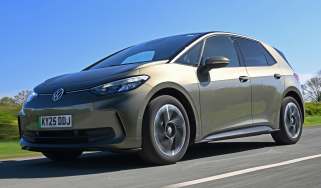Audi A3 - Engines, performance and drive
Audi offers petrol, diesel and plug-in power for the A3, with powerful S3 and RS 3 models heading up the range

The current A3 range is offered with a choice of two petrol engines or a diesel. The petrol options were either a 109bhp 1.0-litre (30 TFSI), a 148bhp 1.5-litre (35 TFSI), with the 1.5-litre employing a 48-volt mild hybrid system, which helps to save fuel and supplies an extra 50Nm of electrically-generated torque.
With the move towards electric power and diesel-engined models becoming less sought after, the decision to trim out the drop the 114bhp 30 TDI and 197bhp 40 TDI models from the A3 range was inevitable. This leaves just the 148bhp 35 TDI as the sole oil-burner in the lineup. We’ve driven the 35 TDI and found it a hard engine to fault, thanks to strong torque delivery and excellent refinement, even under hard acceleration.
We feel sure the petrol A3 35 TFSI model will prove to be a popular choice, and it also benefits from Audi’s decision to offer a more sophisticated multi-link rear suspension, rather than the simpler torsion beam set-up of lower-spec cars. Audi has wisely chosen to keep the A3’s driving dynamics unchanged, resulting in a family hatchback that provides a great mix of comfort and control, although the S line versions still err towards a firmer ride.
Used - available now
If you want a bit more steering feel, we’d recommend toggling through the drive select modes to the Dynamic setting, which provides a bit more weight to the naturally light set-up. Equally, the six-speed manual ‘box has a light throw and is easy enough to get along with, although the transmission is prone to low-speed jerkiness, making driving around town in stop-start traffic harder than it needs to be. The plug-in hybrid TFSI e model also struggles, because the transition from electric to engine power isn’t as smooth as it should be. This model is also lumbered with a weighty battery pack contributing to a more unsettled ride than the standard A3.
The high-performance RS 3 is much more satisfying to drive, thanks in no small part to its trick four-wheel drive system and clever rear differential that can shuffle the engine’s power around to maximise traction. It all makes this a devastatingly quick cross-country weapon. Like the Mercedes AMG A45, the RS 3 can shuffle much of its power back to the rear wheels, making it a much more dynamic car. However, in our comparison test between an Audi RS 3 and a Mercedes-AMG A 45 S, we found the Mercedes to have the edge regarding sharpness and ultimate driver involvement.
0-62mph acceleration and top speed
The sporty S3 and RS 3 models will provide the real performance thrills, but the lower-powered petrol and diesel versions in the A3 range still deliver enough shove for most drivers.
The entry-level 1.0-litre 30 TFSI petrol model has 109bhp and 200Nm of torque, enabling it to reach 0-62mph in 10.6 seconds and onto a 127mph maximum.
Those looking for an extra power boost could consider the 1.5-litre 35 TFSI petrol unit with 148bhp and an extra 50Nm of torque over the base 30 TFSI car. It’ll accelerate from 0-62mph in a lively 8.4 seconds, while the top speed increases to 139mph.
The sole 35 TDI diesel offering has a stout 148bhp output, but the 360Nm of torque on offer makes for decent acceleration and easier overtaking when on the motorway. Like the 35 TFSI, it’ll get to 62mph in a highly respectable 8.4 seconds.
Keen drivers with cash to spare will be in awe of the sprinting ability on offer from the S3 and RS 3 models: the former is capable of 0-62mph in 4.8 seconds, while the latter car's 394bhp knocks a full second off this time – plus it emits a glorious five-cylinder howl whilst doing it.
Heading back down to Earth, we find the pair of plug-in hybrid models. The 201bhp 40 TFSI e will crack the 0-62mph sprint in 7.6 seconds, while the 242bhp 45 TFSI e reduces this further to 6.8 seconds.














